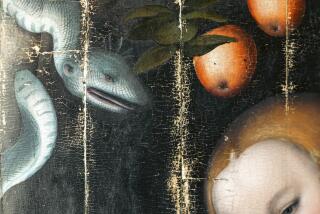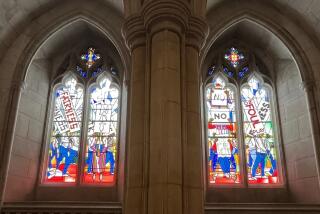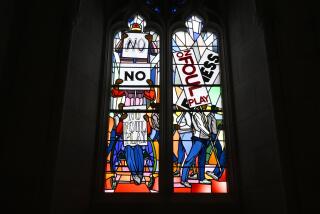Restoring art to its shining glory
CLIFTON, N.J. — Claudia Yeakel was so inspired by the stained-glass windows at Stanford University’s chapel that when her Texas church decided to replace its clear glass windows, she commissioned the studio that produced Stanford’s colorful mosaics.
Each of the three windows designed and built by J&R; Lamb Studios for Christ United Methodist Church in Sugar Land depicts biblical scenes and measures 20 feet wide by 35 feet high. Each cost $180,000.
“Art is a medium that God frequently works through, and has through the ages,” said Yeakel, chairwoman of the Stained Glass Committee.
For more than a century, stained glass in churches and synagogues mostly throughout the eastern United States drew gazes from worshipers. But time, weather and shifting foundations have caused many of the intricate designs to buckle and crack.
That means a lot of business for Lamb Studios, which began operating in 1857 and is the oldest stained-glass maker in the United States. The company started in Manhattan’s Greenwich Village and was at other New Jersey locations before moving to Clifton in 2001.
Lamb is among the top stained-glass studios in the nation, although not a household name like the windows and lamps made by Louis Comfort Tiffany.
“And that’s not because of a lack of quality, it’s just that Tiffany is very fashionable,” said Jane Shadel Spillman, curator of American glass at the Corning Museum of Glass in Corning, N.Y.
Another reason is that Tiffany signed his works, whereas Lamb Studios did not. Spillman said that though Tiffany stopped glass production in the 1920s, Lamb Studios has continued, producing some of the nation’s most notable large works.
The windows that create such devotion are born in a modest workshop in which the power of the colored glass is muted as panes lie on long tables. Classical music plays on a radio as three craftsmen bend over their labors, cutting lead strips with knives in homage to techniques spawned centuries ago in Europe.
One of the artisans, Dominique Raeuber, was reassembling a Tiffany-stained glass window from St. Peter’s Episcopal Church in Lewes, Del. Each segment contained two pieces of glass, and over the decades grime had wriggled past the lead, requiring that the interior spaces as well as the exteriors be cleaned.
“When Tiffany built his windows, he never thought anyone would have to restore it,” said Raeuber, 54, a Swiss native who now lives in Jersey City.
To prevent the interior from again being soiled, Raeuber has edged each two-pane piece with copper foil. The copper will be hidden once the segments are again secured in lead framing.
Because Lamb Studios has been operating continuously for 150 years, some of its renovations involve repeat business -- of a sort -- and restoration represents a growing part of the business.
“I believe we are just looking at the tip of the iceberg of the restoration business,” said owner Donald Samick, who bought the prominent shop from the Lamb family in 1970.
More than half of the shop’s 30-plus current jobs are restorations, Samick said, estimating that Lamb’s revenue last year was about $1 million.
The stained-glass windows at Zion Episcopal Church in Rome, N.Y., were made by Lamb Studios in 1903. Recently, they got an overhaul: All the old lead was removed, the glass was cleaned, several painted areas received touch-ups and then the pieces were reassembled with fresh lead.
The surge in renovation work does not surprise Spillman. “After 100 years, they need work,” she said.
The steep cost of stained glass is among the reasons that new windows are no longer the studio’s mainstay.
In addition, Samick said tastes had changed. “A lot of your New Age religions, especially in the South and Southwest, deal with a more austere interior.”
More to Read
The biggest entertainment stories
Get our big stories about Hollywood, film, television, music, arts, culture and more right in your inbox as soon as they publish.
You may occasionally receive promotional content from the Los Angeles Times.










